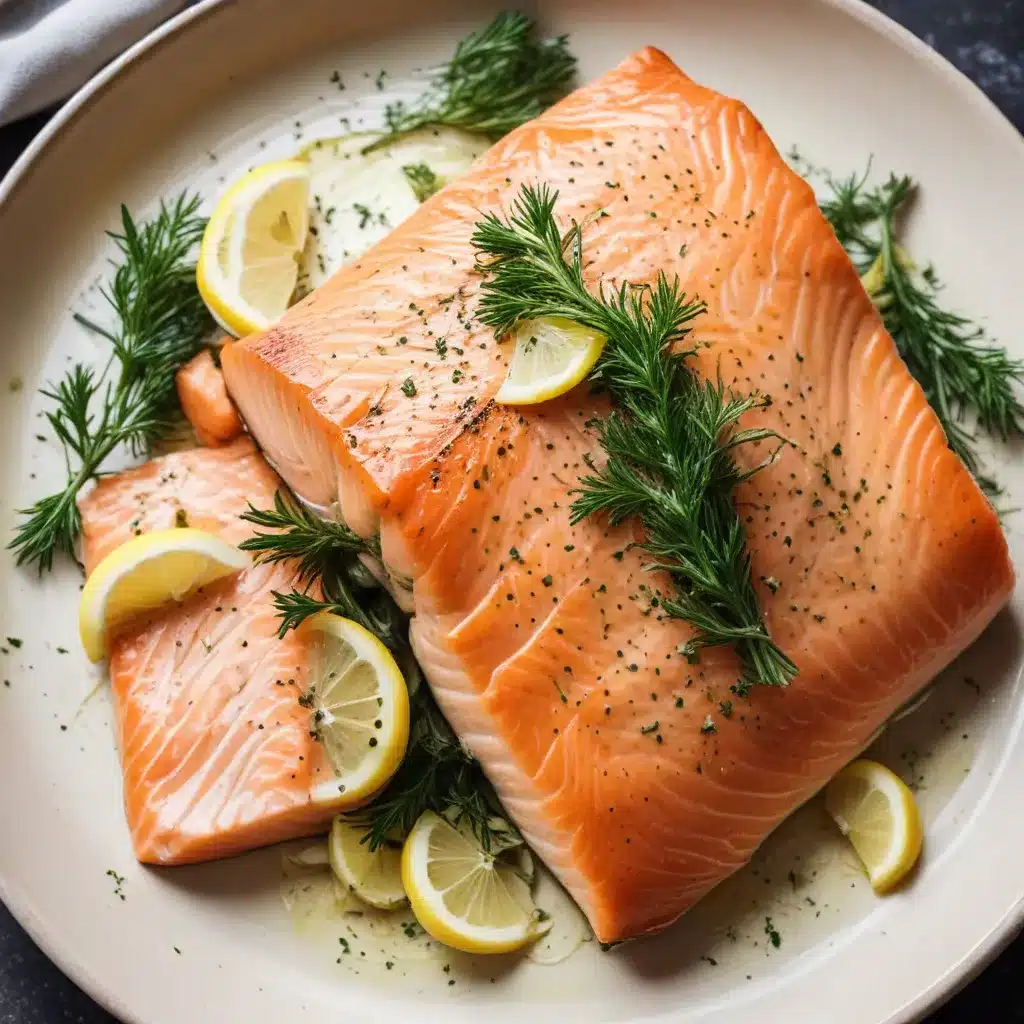
Salmon is a beloved and versatile seafood that can be prepared in countless delicious ways. One of the most satisfying methods is baking salmon fillets with a bright, herbaceous lemon and dill marinade. This approach yields a moist, flavorful result that complements the rich, fatty texture of the fish.
Selecting and Prepping the Salmon
When choosing salmon, look for fillets that are vibrant in color, with a firm, glossy texture. Wild-caught salmon is generally preferable to farm-raised, as it tends to have a cleaner, more pronounced flavor profile. Avoid any fillets that appear discolored or have a strong, unpleasant odor.
Before cooking, pat the salmon fillets dry with paper towels and remove any pin bones using a pair of tweezers. This will ensure a smooth, even texture throughout the fillet. You can also score the skin in a crosshatch pattern, which helps the marinade permeate the flesh and promotes even cooking.
Lemon Accompaniments
Lemon is a classic pairing for salmon, providing a refreshing counterpoint to the fish’s natural oiliness. For this recipe, you’ll want to utilize both lemon juice and zest to achieve a well-rounded citrus profile.
The lemon juice helps to tenderize the salmon and introduces a bright, acidic note that balances the richness of the fish. When applying the lemon juice, be sure to evenly coat the fillets, paying special attention to the thicker portions.
The lemon zest, on the other hand, imparts a more concentrated, aromatic lemon flavor that complements the dill herbs. Grate the zest directly over the salmon just before baking to release the essential oils and maximize the aroma.
Dill Herbs
Dill is a versatile herb that pairs exceptionally well with seafood, especially salmon. Its grassy, slightly licorice-like flavor helps to cut through the fattiness of the fish and adds a refreshing element to the dish.
For this recipe, you can use either fresh or dried dill. Fresh dill will provide a more vibrant, herbaceous flavor, while dried dill has a more concentrated, earthy profile. If using fresh dill, chop the fronds finely and sprinkle them over the salmon just before baking. If using dried dill, a simple sprinkling of the dried herb will suffice.
Baking Techniques
The key to perfectly baked salmon is maintaining a gentle, even heat that cooks the fish through without drying it out. Preheat your oven to 400°F (200°C) and line a baking sheet with parchment paper or a silicone baking mat. This will help to prevent the salmon from sticking and ensure easy cleanup.
Place the salmon fillets skin-side down on the prepared baking sheet. Brush or drizzle the lemon juice over the top of the fillets, then sprinkle with the dill and a generous amount of lemon zest. Season with salt and pepper to taste.
Bake the salmon for 12-15 minutes, depending on the thickness of the fillets. You’ll know the salmon is done when it flakes easily with a fork and the internal temperature reaches 145°F (63°C). If you prefer a more caramelized top, you can finish the salmon under the broiler for 2-3 minutes, keeping a close eye to prevent burning.
Serving Suggestions
Once the salmon is cooked, it’s ready to be served. For a beautiful presentation, arrange the fillets on a platter and garnish with additional lemon slices and fresh dill sprigs. Serve the baked salmon alongside roasted vegetables, a fresh salad, or a simple side of steamed rice or quinoa.
This lemon and dill-baked salmon is also a fantastic meal-prep option. The cooked fillets can be refrigerated for up to 3 days and incorporated into a variety of dishes, such as salmon salads, pasta dishes, or salmon cakes.
Nutritional Benefits
Salmon is an excellent source of omega-3 fatty acids, which are known to promote heart health and reduce inflammation. It’s also a lean protein that is high in vitamins and minerals, including vitamin B12, vitamin D, and selenium. Baking the salmon, rather than frying, helps to preserve these valuable nutrients while keeping the dish relatively low in calories and fat.
Variations and Adaptations
While the classic lemon and dill combination is hard to beat, you can easily customize this recipe to suit your personal preferences. Try substituting the dill for other fresh herbs, such as thyme, rosemary, or basil. You can also experiment with different acidic elements, like white wine, rice vinegar, or lime juice, to create unique flavor profiles.
For a bit of heat, you can add a sprinkle of crushed red pepper flakes or a dash of Dijon mustard to the marinade. And if you’re looking for a gluten-free option, simply serve the baked salmon over a bed of grilled or roasted vegetables, rather than with a starch-based side dish.
Tips for Consistent Results
To ensure your baked salmon turns out perfectly moist and flavorful every time, here are a few key tips:
- Avoid Overcooking: Keep a close eye on the salmon as it bakes, and use an instant-read thermometer to monitor the internal temperature. Salmon is best served at 145°F (63°C), as it will continue to cook slightly even after being removed from the oven.
- Manage Moisture: Patting the salmon fillets dry before cooking helps to prevent steaming and ensures a nice, crisp skin. You can also baste the fillets with the lemon-dill marinade halfway through the baking time to keep them juicy.
- Experiment with Doneness: Some people prefer their salmon on the rare side, while others like it more well-done. Adjust the baking time to suit your personal taste preferences.
By following these simple techniques, you’ll be able to consistently produce delicious, flavorful baked salmon that will impress your family and friends. For more seafood inspiration, be sure to visit Fish Tales Cafe for a wide variety of recipes, tips, and culinary insights.

